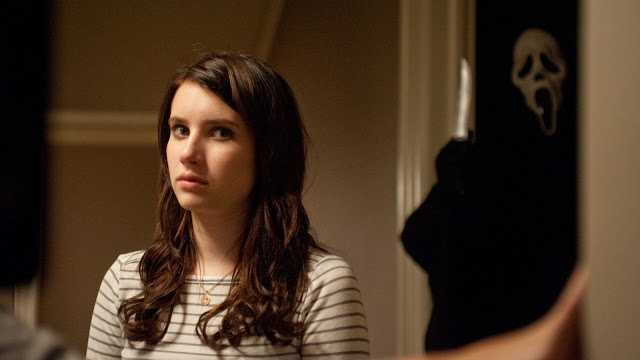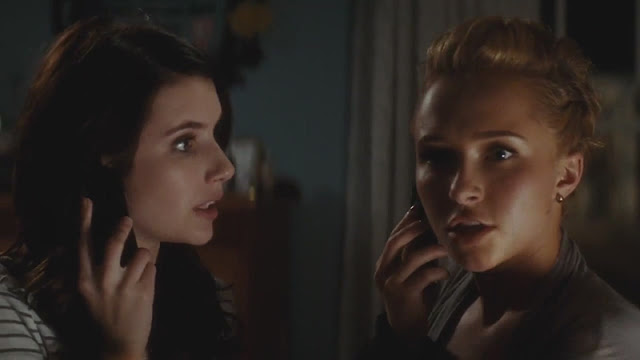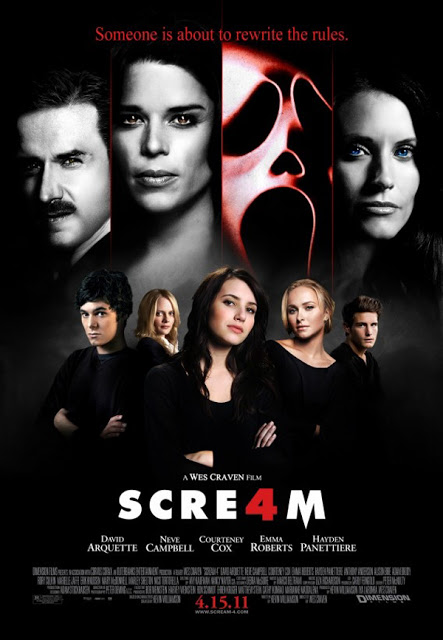 |
Wes Craven’s 1990s Scream trilogy completely rewrote the slasher genre in a postmodern meta-film. In March 2011, Scream 4 was released, ten years after Scream 3 was originally released, starring the original trio: Neve Campbell, David Arquette, and Courtney Cox-Arquette along with some new teen stars to apparently spur a new trilogy. Yet again, this film rewrites the genre, only this time the film plays with concepts of post-racial, post-feminist girl power by making Ghost Face a white sixteen-year-old girl, Sidney Prescott’s cousin Jill (played by Emma Roberts). Craven portrays Jill as the most violent and aggressive killer of any of the other serial killers in the Scream films. Jill kills mostly other white teenage girls (her best friends), a black police officer who is depicted in a racist fashion, and her own mother. Jill’s vitriolic aggression is fueled by her neoliberal pursuit of media fame and self-consciously performing the role of victim while veiling herself as the white-faced killer draped in a black shroud.
 |
|
| Jill Roberts (Emma Roberts) in Scream 4 |
Sidney is constantly stalked by the killer and becomes an attempted target in her house, but she eventually manages to stop him and take refuge in her room. Time passes and characters develop a little more before the final scene during a house party at Sidney’s schoolmate, Stu’s house. The killer attacks the kids at the party, and Sidney is left alive to confront, who she discovers, are two killers: her boyfriend Billy and his friend Stu. They confess to having raped and killed her mother one year before. Gail comes in and briefly deters the two killers from killing Sidney, but in the end Sidney manages to kill both of them, declaring, as her surviving friend Randy comments, “Be careful, they always come back for one last scare,” and just as Billy sits up surprisingly, Sidney shoots him in the head, and she states, “Not in my movie,” claiming the construction of the Final Girl as a place of productive empowerment for girls and violent defense against women-hating men.
 |
| Sidney Prescott (Neve Campbell) in Scream 4 |
“Pornography thus engages directly (in pleasurable terms) what horror explores at one remove (in painful terms) and legitimate film at two or more.”
The affect of terror and pleasure, though, seem to also be blurred when thinking about slasher films. Audiences are entertained by the desire to see violence that is unseen. They get a horrific glimpse into the pain inflicted between humans (mostly men killing women), but one productive element of the Scream series presents a productive feminist subversion of these elements of pleasure, pain, humor, and gender. Clover qualifies the commonly found surviving girl at the end of horror films in her essay, “His Body, Himself: Gender in the Slasher Film”:
“The image of a distressed female most likely to linger in memory is the image of the one who did not die: the survivor, or Final Girl.”
And this position of the final girl in horror films is destabilized in Scream 4, as the final girl and masked killer are the same person.
“According to the logic of realism, Scream might well be seen as endorsing violence in the hands of a teen girl. But when viewed in its cinematic context, the film, like the slasher genre in general, provides an opportunity to examine cultural and individual fantasies as they relate to gender and power.”
The girl violence in the Scream films takes a new direction as Jill takes on the role of the killer and enacts violent murders against mostly white teenage girls, a black man, and her own mother in the film, symbolically, hyperbolically constructing post-feminist girl power gone horribly wrong. Jill’s performs a coy demeanor and unassaultive character at the beginning of the film, which is starkly contrasted after her unveiling to Sidney as the killer in the second to last scene of the film. She asserts her position as the “empowered” female remake of Billy as the killer and Sidney as the victim, saying “I don’t want to be like you. I want to become you,” right before she stabs Sidney, thinking she murders her. Jill then proceeds to stab herself, throw herself onto a glass coffee table (evocative of a scene out of Fight Club) as a way to bodily victimize herself.
“We recognize the Apple computer symbol, I think, as a clever icon for the digitalization of the creation myth [. . . ] The bite now represents the byte of information within a processing memory.”
He discuses the temptation of biting into the forbidden fruit, which Eve does despite the prohibitions offered by God to her and Adam in Eden. Halberstam relates this Biblical story to the marketing of Apple products with the bitten apple logo on Apple products representing a capitalist seduction of consumer technology and information. Craven takes this concept one step further by having most every character in Scream 4 tote around some Apple product. The Ghost Face killer calls different characters on their iPhones before each murder. The killers use Apple technology to facilitate and capture the murders on film by using webcams to record each murder and post them onto their blog, reconstructing a do-it-yourself remake of the first Scream film within the sequel. The placement of Apple products throughout the film could be read as a synergistic business pursuit by the film makers, and in some ways, people probably were influenced to purchase a new iPhone after seeing this movie. The film also skillfully challenges the obsessive (mis)use of technology, and the Apple products, to use Halberstam’s analysis, symbolize capitalist seduction and female exploitation through violent murders. In “The Scream Trilogy: “Hyperpostmodernism” and the Late Nineties Teen Slasher” by Valerie Wee, she deconstructs the hyperpostmodernism in the Scream films:
“This shift to hyperpostmodernism was motivated by several factors: (1) the development of new media technologies such as cable, video, and an increasing range of digital media; (2) the emergence of a new teen demographic in the United States; and (3) the entertainment industries escalating commitment to cross-media promotional and marketing practices.”
As Wee argues, the Scream franchise’s insistence on including new media, promotion, and adjusting to the “emergence of a new teen demographic” applies perfectly to Scream 4’s hyperpostmodernism as a next step in the evolution of the series.
 |
| L-R: Jill Roberts (Emma Roberts) and Kirby Reed (Hayden Panettiere) in Scream 4 |
The teenage girls in Scream 4 are constantly on their iPhones in the film and are connected to Ghost Face through their phones. In the first scene of the film, there is a comment made that there is now a Ghost Face app. for the iPhones so anyone can replicate the killer’s voice as a prank call to friends. Female bodies become fused with technology: they become as fused with it as it is their source of survival and simultaneously the killer’s invasion into their white middle-class spaces. Halberstam writes:
“The female cyborg, furthermore, exploits a traditionally masculine fear of the deceptiveness of appearances and calls into question the boundaries of human, animal, and machine precisely where they are most vulnerable — at the site of the female body.”

